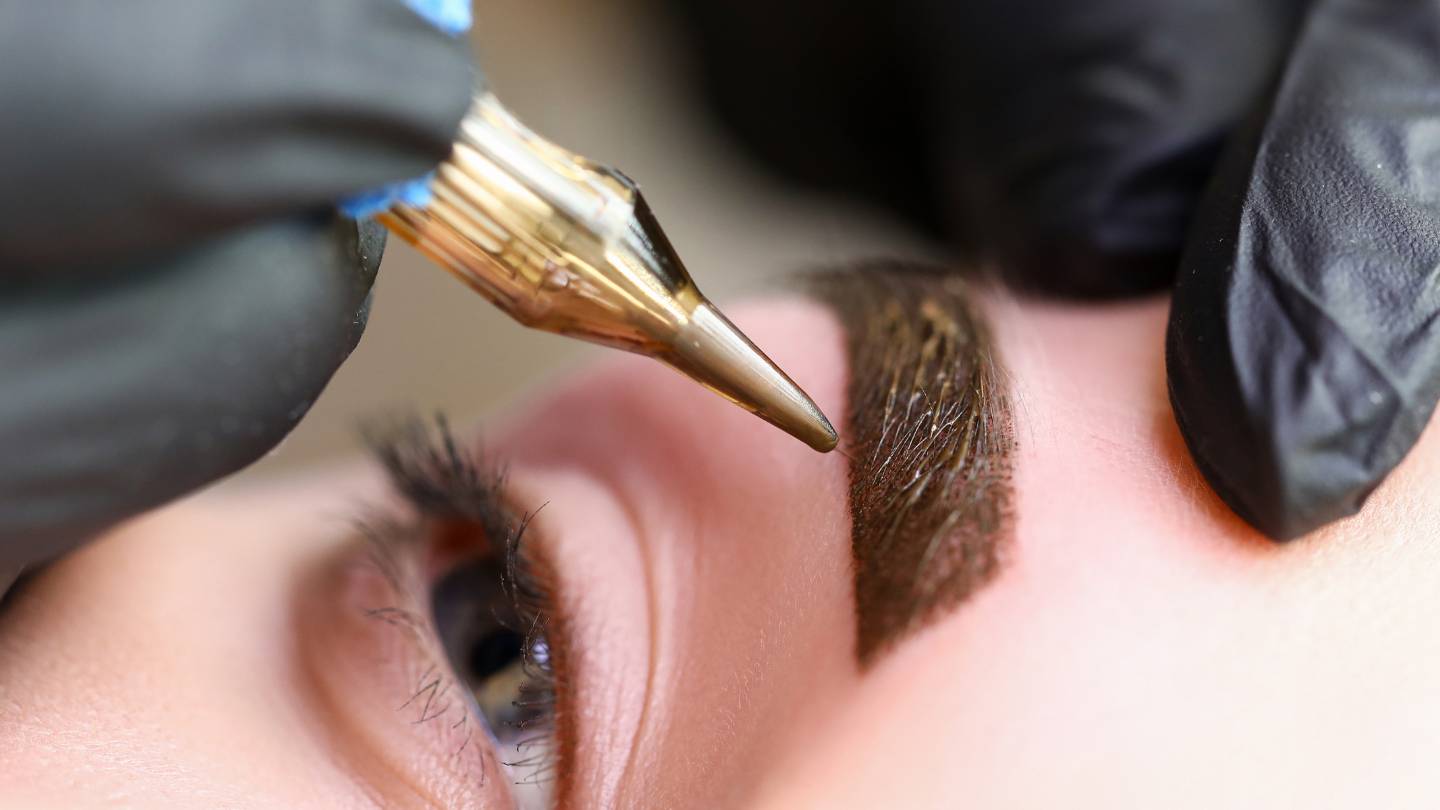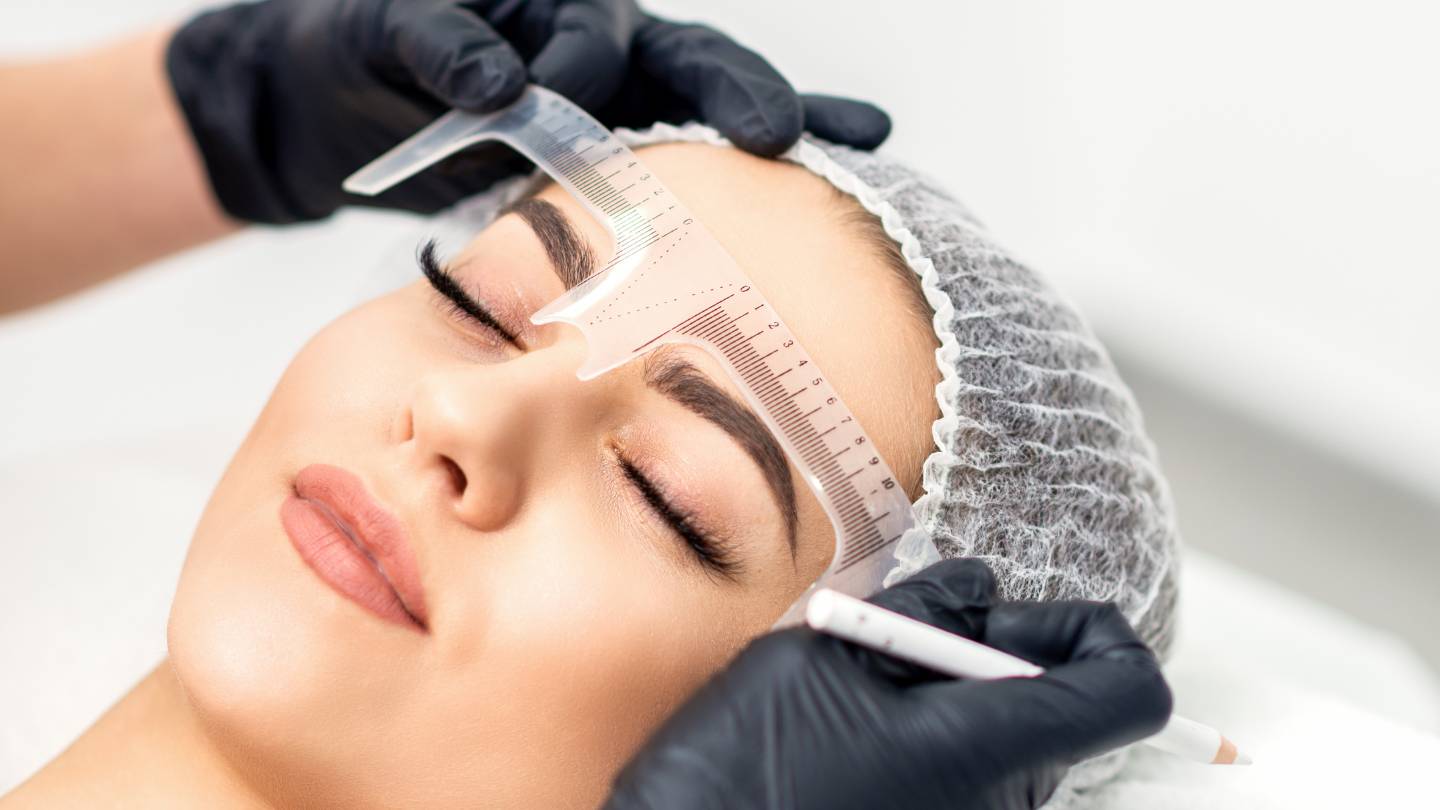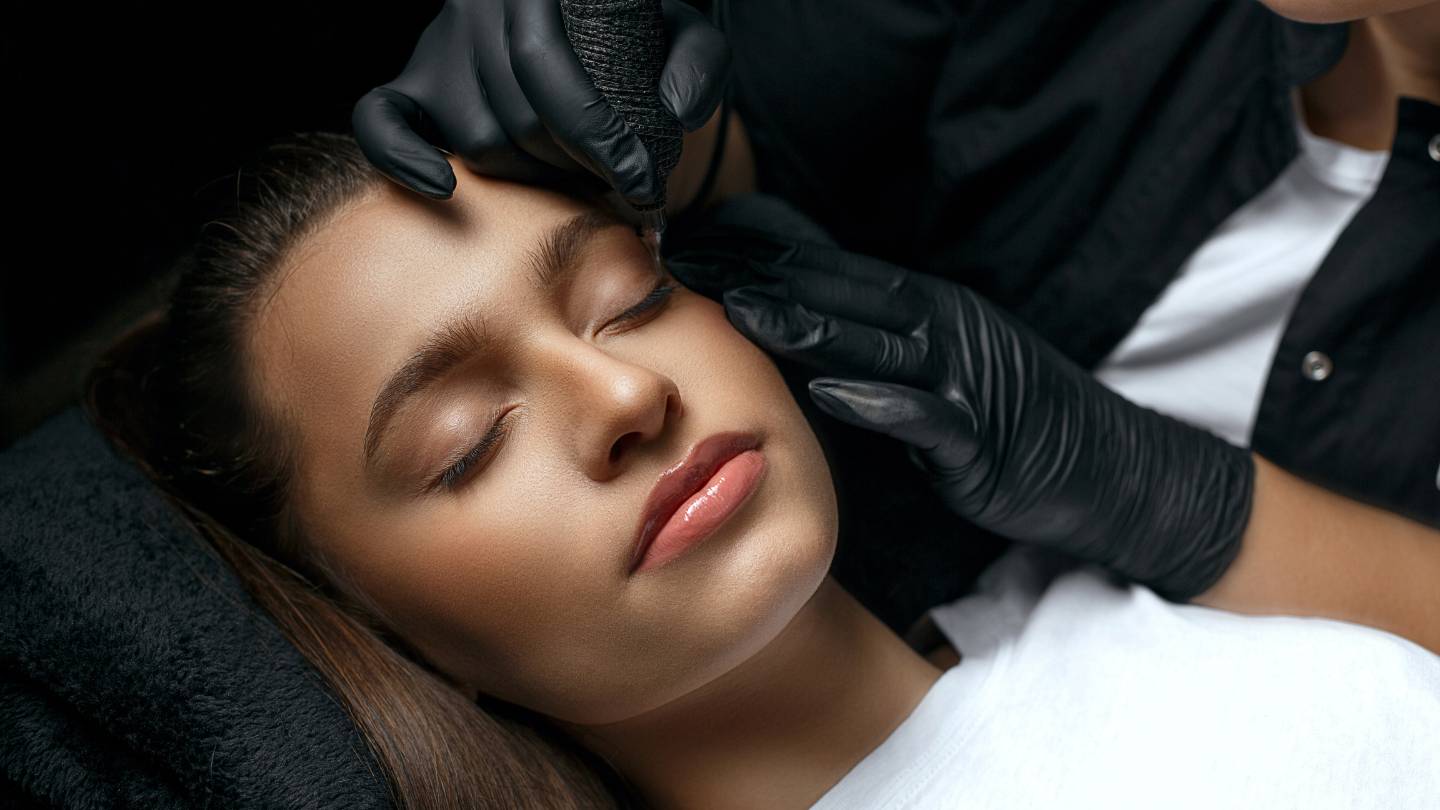Beauty enthusiasts often find themselves deliberating between microblading and traditional eyebrow tattooing in pursuit of flawless eyebrows. The quest for perfectly shaped brows has led to the emergence of various techniques, each promising impeccable results.
Understanding the nuances between microblading and eyebrow tattooing is essential for individuals seeking a semi-permanent solution to enhance their brows.
Microblading, a semi-permanent cosmetic procedure, involves creating hair-like strokes using a handheld tool with fine needles, providing a natural and defined look.
On the other hand, eyebrow tattooing, often associated with permanent makeup, uses a machine to implant ink into the skin for a more saturated and enduring effect.
Delving into the distinctions between these techniques is crucial for anyone aiming to achieve the ideal eyebrow aesthetic tailored to their preferences and lifestyle.
What Exactly Is Microblading?
To achieve thicker, more naturally seeming eyebrows, an aesthetician can use microblading. When a numbing cream is applied, little punctures are created in the brow that resemble your hair. Next, pigment is injected into these cuts.
Because the microblade makes shortcuts and a numbing cream is given beforehand, microblading is not very painful. There shouldn't be much bleeding. The colour stays contained within the incisions without flowing outward since only a small amount of pigment is utilised.
The effects of microblading can endure for one to two years, albeit they do decrease with time. On the other hand, regular "maintenance" treatment sessions allow patients to prolong the duration of their effects.
What Exactly Is Eyebrow Tattooing?
A tattoo of the eyebrows is the same as any other tattoo. Your tattoo artist will use a needle powered by an electric source and filled with ink. Using a rapid tapping motion, the needle repeatedly enters your skin, applying ink through the deeper layers within the dermis.
Although tattoo colours and lines may fade and blur with time, the ink is permanent. It is next to impossible to get an eyebrow tattoo removed.
Eyebrow Tattooing Vs. Microblading
Knowing the distinctions between the two methods of augmenting your eyebrows will help you decide which is right.
Permanent Vs. Temporary
For most individuals, the duration that the effects of microblading & eyebrow tattoos last is the main distinction between the two.
Inked eyebrows stay put. As previously said, unwanted fading from the ink is possible, but once tattooed, the ink stays there permanently. Unless you go through the process of getting a tattoo removal kit, getting an eyebrow tattoo is a permanent decision.
In contrast, microblading usually produces effects that last anywhere from six months to a year. The pigment doesn't penetrate as deeply and fades with your skin's natural cell turnover.
For those who want to keep their microbladed brows looking great, it takes a simple "touch-up" treatment once a year. Because microblading is only semi-permanent, patients can easily alter their brow style to match shifting fashion trends.
Tattoo Pigment Vs. Microblade Pigment
Pigments for microblading can be either organic or inorganic, and they come in a rainbow of colours. Even if the microblading ink gradually fades, the shade remains unchanged. For a more natural look, microblading pigment gradually fades into a lighter shade of the original colour. Because of this, the end product will not look artificial until it completely disappears.
Different pigments are utilised in microblading and traditional tattoo ink for brow tattooing. The fading process is one major manner in which ink differs from pigment. Tattoo ink, particularly along the tattoo's borders, might take on a blueish-green hue as it fades.
As the red pigments in black tattoo ink fade, the colour might change to blue or green. Because of this, some people get eyebrows that look like they were drawn with a Sharpie. The end effect can be brows that look extremely artificial.
Needling Vs. Blading
When performing microblading, a hand tool is used to cut carefully into the epidermis, the outermost layer of skin. It is far easier on the skin than getting a tattoo, but it also heals faster and leaves less scarring. Another benefit is that less pigment is required, which means that colour won't "bleed" into neighbouring skin cells.
A tattoo machine can reach deeper layers of skin than a human artist can. Tattoos are typically more painful than microblading because of this.
Because the holes are so large, more ink is squeezed out than is necessary, and the colour "bleeds" onto the surrounding area. The very deep needle punctures inflict damage to the skin, which needs healing, adding time to the recovery process.
Filled Brows Vs. Fine Lines
Professionals in microblading are masters in drawing hair-like strokes that appear and feel just like real eyebrow hair. When applied to the eyebrows, these lines create an effect that is nearly impossible to tell apart from your hair.
Even the most skilled artists struggle to create the delicate lines seen in microblading when using a tattoo needle. The same level of precision doesn't work while tattooing. Tattooed brows look more like filler than natural brows because of their more solid appearance.
Natural-looking Result
Compared with eyebrow tattooing, which leaves the patient with "drawn on" and flat brows, microblading produces a more realistic look.
This is because microblading replicates the natural pattern of hair growth in the eyebrows, resulting in strokes that seem like real hair. A skilled microblading artist can simulate the appearance of thicker natural brow hair in treated areas.
Pain
Getting a tattoo, particularly on a delicate skin area like the face, can be uncomfortable. The pain is significantly reduced with lidocaine applied to the brow area before microblading. Most patients compare microblading to the sensation of tweezing.
Tattooing And Microblading: Pros And Cons
There are distinct advantages to getting the eyebrows microbladed or tattooed, and they vary according to the style of brows you choose.
Each approach has advantages and disadvantages, so choosing one will come down to personal preference, budget, and the amount of time you're willing to spend on your brows.
Eyebrow Tattoo Pros
The benefits of getting an eyebrow tattoo primarily consist of the following:
- Recovery is a breeze
- Not a huge time commitment
- Greater durability
- Very little discomfort
- Reducing costs and saving you time over time
The obvious most important is the effort and cash it saves you. Even a short amount of time, like ten minutes in the morning, to shape your eyebrows can build up.
How much you shell out for brow cosmetics is a case in point. Spending around $5 a month on brow cosmetics might build up to a significant amount in a year.
Not the most important advantage, but certainly a pleasant one, is that it eliminates the need for someone who could be better with cosmetics to worry about drawing their brows correctly or touching them up in the middle of the day.
When you're trying to draw your brows precisely but keep smudging them, it can be not very pleasant. You can avoid this trouble and stress by getting an eyebrow tattoo.
Finally, eyebrow tattoos can be a godsend for people who have trouble applying makeup ordinarily. Among them may be people who have:
- Skin sensitivities to cosmetics
- Impaired mobility
- Blind
- Deficit in ambidexterity
- Are there any other concerns when putting on makeup?
There are benefits to thinking about the potential drawbacks of eyebrow tattooing.
Eyebrow Tattoo Cons
- A few drawbacks of getting an eyebrow tattoo are:
- They may cause discomfort.
- Up front, they can be pricey.
- Colours may gradually fade over time.
- Painful recovery procedure
- Permanently non-existent
Getting your eyebrows tattooed can be as painful as getting any other tattoo. A person's pain tolerance level determines how quickly the discomfort of having a needle inserted with ink into their skin can become unbearable. You can alleviate some discomfort by applying a numbing cream before your session.
Getting an eyebrow tattoo might appear costly initially, but it saves you money. You should expect to pay between $400 and $600 for your initial session, with an additional $150 for yearly touch-ups. Compared to wearing eyebrow makeup and always buying more, it's worthwhile if you think it's worth it.
The method's lack of permanence is its main drawback. You can only call them temporarily, as you must keep scheduling touch-up visits. We don't recommend getting eyebrow tattoos if you plan on having only one procedure.
Brow Microblading Pros
Microblading has several advantages, such as:
- Resists smudging and wear-off
- Sessions are even more efficient
- Very long-lasting
- The colour of the pigment remains constant.
Rather than applying cosmetics on top of your face, microblading implants pigments in the top three layers of your skin. Therefore, sweat from exercise or water from swimming won't smear the pigment.
Microblading eliminates any concern you may have had about the length of time required for eyebrow tattooing treatments. The average duration of a session is just over 1.5 hours. A one-and-a-half-hour session is a bargain when you consider that you need to spend around fifteen minutes daily on your eyebrows.
Sunlight and other external elements also do not affect the pigment's colour. They will fade and lose saturation over time, but that's just a sign that you should have a touch-up!
Brow Microblading Cons
- The pros and cons of microblading are as follows:
- The disease
- Pricey upfront
- The process of scarification
- An allergic response
A skin infection could result from your specialist using contaminated or subpar equipment. If you've ever had skin infections or have a history of delicate skin, that could also be a factor. You can avoid these disasters by seeing a trustworthy expert with a solid reputation.
Scarification may occur throughout the removal process if you elect to remove the microblading. Scarification occurs when an external force changes the skin's texture. Though it won't damage your brows, microblading isn't the way to go if you're worried about irritating your skin or have sensitive skin.
When choosing between these two eyebrow treatments, weighing the benefits against the potential drawbacks is important.
The Durability Of The Treatments
Microblading and eyebrow tattoos have quite different expected lifespans.
Microblading Lifespan
Permanent makeup techniques like microblading use pigments that, based on your skin type & lifestyle, dissolve after one to two years.
This fading happens over time, and you may need to touch up your microblading occasionally, depending on your tastes.
Let these fade if you become tired of this look, another advantage of this technique. The pigments will fade as time passes, becoming progressively lighter and less noticeable. You can speed up the fading process as well.
Several removal options are available if your microblading goes awry.
Traditional Lifespan Of Eyebrow Tattoos
But conventional eyebrow tattoos aren't going anywhere.
The ink disappears after insertion and does not come out. It may gradually lose part of its lustre over time but never completely disappear. One potential issue with eyebrow tattoos, as opposed to microblading, is that the ink colour might vary, occasionally going from black to pale green or bluish. The hue gradually loses its lustre and vibrancy as time passes.
Which One Is Best?
The benefits and drawbacks of microblading & eyebrow tattooing are similar. We've reviewed each one to assist you in finding the finest eyebrow enhancement procedure.
Choose a tattoo artist specialising in permanent makeup and eyebrows or a microblading aesthetician once you've decided. Please get to know their reviews and ask to view before and after pictures of previous patients before you commit to the operation.
Conclusion
Microblading and eyebrow tattooing are two popular cosmetic procedures for enhancing eyebrows. Microblading involves creating hair-like strokes using a handheld tool with fine needles, providing a natural and defined look. It is less painful and requires minimal bleeding, while eyebrow tattooing uses a machine to implant ink into the skin for a more saturated and enduring effect.
Eyebrow tattooing is similar to tattooing but uses a needle powered by an electric source and filled with ink. The ink is permanent and cannot be removed. The effects of microblading can last for one to two years, while eyebrow tattooing is permanent and requires a tattoo removal kit.
The main difference between microblading and eyebrow tattooing is the duration of the effects. Inked eyebrows stay put, while microblading produces effects that last anywhere from six months to a year. Tattoo pigments can be organic or inorganic and come in a rainbow of colors. Microblading pigment gradually fades into a lighter shade of the original color, making the end product look natural.
Needling is easier on the skin than microblading, as it heals faster and leaves less scarring. Tattoos are typically more painful due to deep needle punctures and the need for healing. Microblading produces a more realistic look, replicating the natural pattern of hair growth in the eyebrows. Pain can be reduced with lidocaine applied before microblading. Choosing between microblading and eyebrow tattooing depends on personal preference, budget, and time commitment.
Eyebrow tattoos offer several benefits, including easy recovery, less time commitment, greater durability, and minimal discomfort. They also reduce costs and save time over time, making them a great option for those who struggle with applying makeup. However, eyebrow tattoos can cause discomfort, be expensive upfront, and may fade over time.
Microblading, on the other hand, has several advantages, such as resisting smudging and wear-off, being more efficient, and being very long-lasting. The pigment remains constant, and the average session duration is just over 1.5 hours.
However, microblading has its pros and cons, including potential diseases, high upfront costs, scarification, allergic reactions, skin infections, and scarification during removal. It is recommended to choose a trustworthy expert with a solid reputation and avoid using contaminated equipment. Scarification may occur during removal, but it won't damage the brows if sensitive skin is concerned.
Microblading and eyebrow tattoos have different expected lifespans. Microblading uses pigments that dissolve after one to two years, and you may need to touch up your microblading occasionally. The pigments will fade over time, becoming lighter and less noticeable. There are several removal options available if your microblading goes wrong.
Eyebrow tattoos, on the other hand, have a traditional lifespan, as the ink disappears after insertion and doesn't completely disappear. To find the best eyebrow enhancement procedure, choose a tattoo artist specialising in permanent makeup and eyebrows or a microblading aesthetician.
Content Summary
- Microblading and eyebrow tattooing are popular techniques for achieving perfect eyebrows.
- Microblading is a semi-permanent cosmetic procedure creating hair-like strokes.
- Eyebrow tattooing involves machine implantation of ink for a saturated effect.
- Microblading uses fine needles to create natural and defined brows.
- Eyebrow tattooing is more enduring and often associated with permanent makeup.
- Microblading involves making small punctures in the brow area.
- A numbing cream is applied during microblading for minimal pain.
- Microblading results can last up to two years with maintenance treatments.
- Eyebrow tattooing is similar to other body tattoos using an electric needle.
- The ink from eyebrow tattoos is permanent but may fade or blur.
- Microblading is semi-permanent, allowing for more frequent style changes.
- Microblading pigment can be organic or inorganic with a range of colours.
- The pigment used in microblading fades into a lighter version of the original colour.
- Eyebrow tattoo ink can change to blue or green as it fades.
- Microblading uses a hand tool, which is gentler on the skin.
- Tattoo machines can reach deeper skin layers, causing more pain.
- Microblading causes less skin damage and quicker healing than tattooing.
- Microblading produces fine lines resembling natural eyebrow hair.
- Tattoo needles struggle to replicate the precision of microblading.
- Microblading offers a more natural result compared to eyebrow tattooing.
- Microblading is less painful due to the application of lidocaine.
- Eyebrow tattooing and microblading have pros and cons depending on preferences.
- Eyebrow tattoos offer ease of recovery and long-lasting results.
- Tattooing reduces ongoing costs and saves time on makeup.
- Eyebrow tattoos can benefit those with cosmetic application challenges.
- Tattooing can be painful and requires a substantial upfront cost.
- Tattoo colours may fade unevenly over time.
- Microblading resists smudging and is very long-lasting.
- Microblading sessions are efficient, taking just over 1.5 hours.
- The pigment colour in microblading remains consistent as it fades.
- Risks of microblading include infection and allergic reactions.
- Microblading may cause scarification during removal.
- Microblading pigments dissolve after one to two years.
- Fading microblading allows for style changes or complete removal.
- Traditional eyebrow tattoos are permanent with no fading.
- Ink colour in eyebrow tattoos can alter over time.
- The choice between microblading and tattooing depends on individual needs.
- Eyebrow tattoos require a commitment to a permanent look.
- Microblading offers flexibility in changing eyebrow styles.
- When choosing a procedure, research and reviews of the artist are important.
- Consider the longevity of the results when choosing between the two methods.
- Microblading can be touched up or allowed to fade naturally.
- Eyebrow tattoos maintain their shape but may lose vibrancy.
- The decision should be based on lifestyle, budget, and personal preferences.
- Microblading is suitable for those wanting a natural and less permanent solution.
- Eyebrow tattooing is ideal for those seeking a long-term solution.
- Both techniques offer distinct advantages in eyebrow enhancement.
- Professional expertise is crucial for successful microblading or tattooing.
- Before committing, ask to see before-and-after photos of previous clients.
- The choice between microblading and tattooing significantly impacts brow aesthetics.
Frequently Asked Questions
While both microblading and eyebrow tattooing are forms of cosmetic tattooing, they differ in the technique and the tools used. Microblading uses a manual blade to create precise, individual strokes that resemble natural hair, resulting in a more realistic and natural look. Traditional eyebrow tattooing, on the other hand, often involves a machine and can create a more solid, filled-in appearance.
No, microblading is not permanent. It is considered semi-permanent because it doesn't go as deep into the skin as traditional tattooing. Microblading typically lasts 1-3 years, depending on skin type, aftercare, and lifestyle. Eyebrow tattoos are generally more permanent and may last longer.
The pain level can vary from person to person, but microblading generally tends to be less painful than traditional eyebrow tattooing. This is because microblading involves a manual tool that creates smaller, shallower incisions than the machine used in tattooing.
One of the primary benefits of microblading is its ability to create natural-looking eyebrows. The fine, individual strokes mimic the appearance of real hair, providing a more realistic and less "drawn-on" look compared to some eyebrow tattoos.
The healing process for both procedures is relatively similar. The initial healing typically takes about 1-2 weeks, during which scabbing and flaking may occur. However, microblading may have a shorter healing time since it involves smaller incisions.



